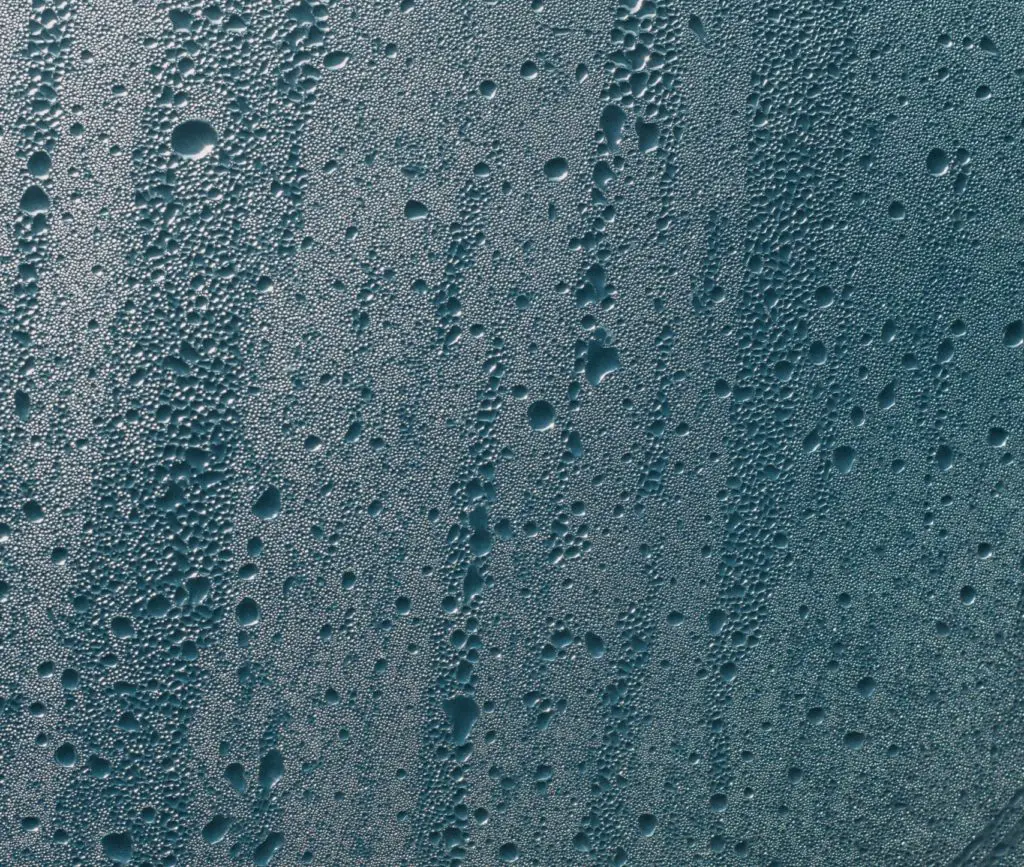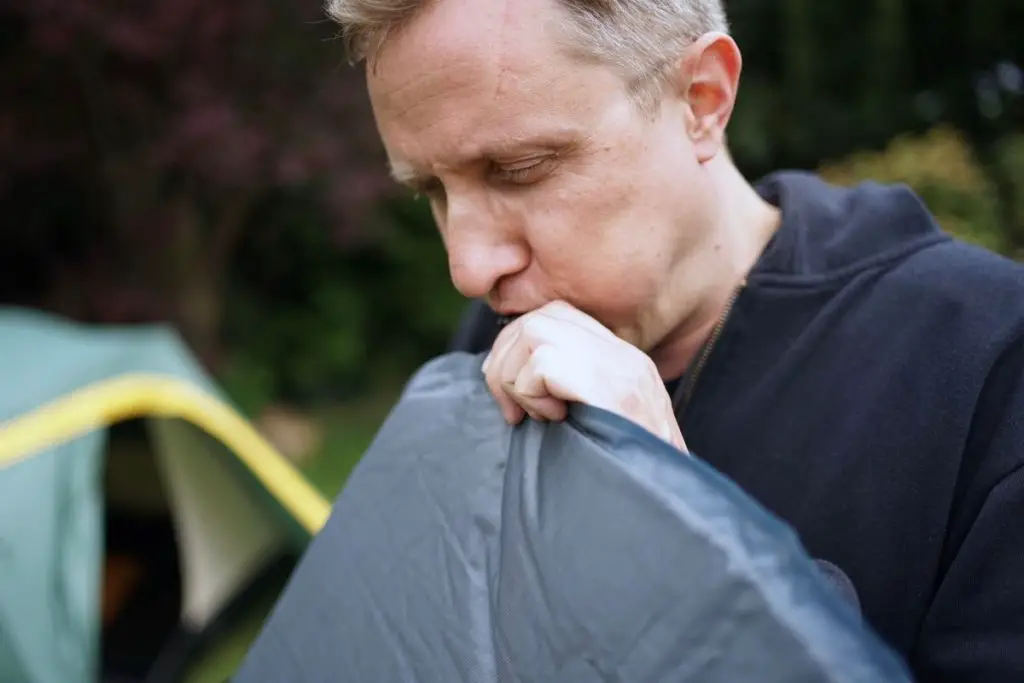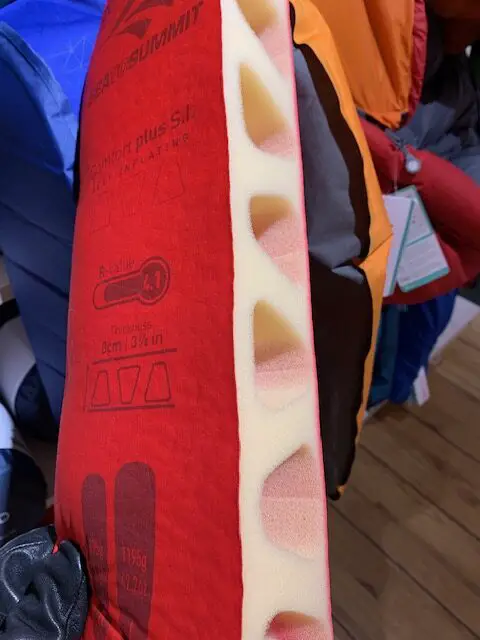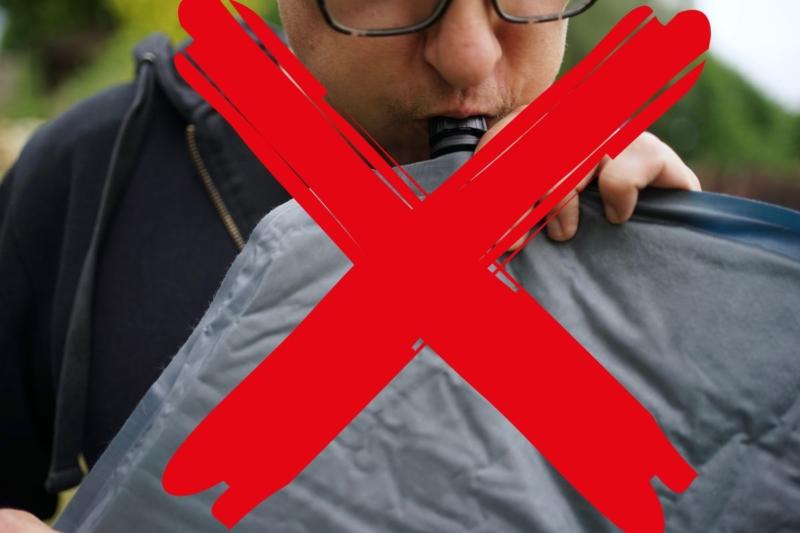As a microbiologist, I know better than anyone that bacteria and fungi, like us, need water and heat to survive. Therefore, blowing your smelly humid exhaust into your mat just to heat it up all night with your sweaty body will definitely render it a suitable incubator for nasty microbes!
A moldy sleeping pad may result from using your breath as the source of air when inflating your mat, however, there are several other methods to consider when inflating a sleeping mat that may save your mat from rotting from the inside!
So let’s look into how to avoid mold in a sleeping pad!
Contents
Is inflating my sleeping pad by mouth bad?
Yes! When most people think of blowing air into their mat, they think of the good old mouth to valve way! As we will see, this is both cumbersome, unnecessary and eventually leads to rot and mold.
It is also clearly the most cumbersome way of filling up your mat, and will provide microorganisms with the humidity needed for their growth.
The truth is, that doing this a few times once in a while will not hurt your mat. Humidity and warmth are not enough to render your sleeping pads’ interior as smelly as the bacterial cultures we grow in the lab.
The right microbes need to be present inside your mat and they also need other nutrients (read: food) to thrive properly.
Those nutritious left-over food particles from your evening meal may contribute to feeding those microbes (which is another good reason to brush your teeth before going to bed), however, some microbes might also be able to digest the actual sleeping pad material (just as some microbes can live on crude oil!).
The thing is, fungi and bacteria like molds can eat almost any organic material as long as you provide the humidity!
Although, as a nutrient-poor environment it will take some effort to really get contamination going.

How to know if your sleeping pad has mold?
Unless you want to tear your precious sleeping pad apart or have access to an advanced microbiology lab, there is no 100% certain way of figuring out if your sleeping pad is contaminated. If contamination is bad enough though, you will smell it upon deflation of the mat!
If it has mold or mildew, it will smell like an old basement or that fluffy green stuff on the loaf of bread you once forgot in the back of your cupboard (yeah, you know what I mean!).

Another manifestation of mold may be dark spots on the inside linings of the sleeping pad, which are most visible by viewing through the sleeping pad when holding it against some powerful light source such as the sun. If dark spots or irregularities appear, this may be a sign of mold in your pad.
The best way to avoid blowing up a pad by mouth is to use an small electric pump or a pad with a build in foot pump.
What kind of microbes grow inside of a sleeping pad?
I did a small experiment to figure out what microbes would be in my own Thermarest Neoair sleeping pad I have had for 3 years now. So I brought my sleeping pad to the lab, filled it with air, and let the air blow out (in a sterile environment of course) onto an agar plate.
The agar plate will allow microbes present in the air to grow and become visible after a certain incubation time. After three days of incubation, the following appeared:

An exhaust of air from my own sleeping pad.
Here you can see that some stuff is growing on the agar plate. The big green fluffy colonies are fungus mold, they likely originated from spores inside my sleeping pad. The small white dots are some bacteria.
From my experience, they look like something that would normally be present on human skin, but they could also come from soil or the mouth.
Is it safe to sleep on a moldy mat?
For an inflatable mattress, it is safe to sleep on it, but this is not your main concern. The main problem is when you empty the air inside your room or tent and all the mold/fungus spores are released into the air where you risk breathing it in!
Therefore, if the damage is done and your pad is moldy inside, be sure to always empty the air out in a well-ventilated area such as outside.
How do you get mold out of a sleeping pad?
Depending on the severity of mold growth inside your sleeping mat, you might have a pretty good chance of reversing the growth of fungus mold in your mat.
As soon as you discover an odd smell or visual signs of contamination of your mat, give it a break from oral inflation for a while and leave the valve open to allow the inside to dry out.

I do not recommend applying any disinfectants etc. to the interior of your sleeping pad as this would risk damaging the materials prove more toxic than helpful.
If you want to speed up the recovery, you might consider placing a dehumidifier in the same room as your pad.
The best way to avoid the mold problem is to avoid letting your foul breath into the sleeping pad in the first place. Se the list of superior inflation methods below!
OutlifeExpert
So let’s take a look at some quite attractive alternatives to mouth inflation.
What are the alternative to inflating a sleeping pad by mouth?
While sitting blue-faced in a tent late at night to inflate your moldy sleeping pad by mouth will definitely save you some weight and cash, there are numerous gadgets out there to make the task somewhat less daunting and less attractive to microbes.
1. Using an electric pump – Flexitailgear pump review.
Although it does not sound very much in line with the philosophy of lightweight camping to carry a pump with you on the trail, an electric pump can be a very good and clean option to inflate your mat.
Because the clean outside air goes directly into the mat, you avoid the high humidity and mold risk of your breath. I personally own the cheap flextailgear tiny pump X and I must admit that I am really surprised how well it works!

So, this pump only weighs 80g (2.8oz) but boasts a 20 min operation time. It has a build-in rechargeable battery and comes with different nozzles to fit any sleeping pad. It also has a built-in LED lamp that can be adjusted to three different strengths: 40lm, 160lm, and 400lm.

The tiny pump X comes with adapters that fit any mat I have tried so far. Check the latest price of the Tiny X pump on Amazon.
The best ultralight backpacking air pump?
So most single-person pads I have inflated including the Klymit static V, the Thermarest Neoair, and single-person Naturehike mats, inflate in around one minute with this electric pump. The only two-person sleeping mat I have tried is this one which is fairly cheap, which took around two minutes to inflate with the electric pump.
This is impressive considering it takes me approximately 5 and 10 minutes respectively to inflate these mats by mouth! It is a serious luxury to watch this thing in action after a long day of hiking.
The only downside of most electric inflation pumps is the noise they make (listen to the sound in the video above!), which might disrupt the calm nature vibes – as though sleeping pads are not noisy enough on their own…
Another limitation is the need for a source of electricity to charge the pump when it runs dry
From my experience though, you can easily go on a 10 day hike with a single person sleeping mat and still use the built in lamp for a while, without needing to charge the pump.
Bolngla also makes a pump with a higher battery capacity of 2000mAh, the BOLNGLA Air Pump. It is slightly bigger but will last for weeks on the trail and can be used as a power bank along the way.

2. Using a pump sack to inflate your mat
Another popular option is to use a pump sack to inflate your sleeping pad. As a pump sack requires your manual operation, and thus not as luxurious as the electric pump, it can be equally daunting to oral inflation.
However, although some people blow air (by mouth) into the sack before compressing it to inflate their mat, a pump sack is much better in terms of avoiding mold buildup.
I have a fairly large pump sack that came with my two person sleeping mat, that works well and gets the mat inflated in around the same time as by using my lungs.

In my experience a pump sack works well and doubles as a waterproof stuff pouch to store my stuff, e.g. clothing, as well. The downside of pump sacks is that they are all made to fit a specific valve design and therefore I have yet to find a pump sack that fits all my sleeping pads.
The therm a rest pump sack is another good choice for people using the neo air mattress.
3. Sleeping pads with built in pumps
While carrying an external pump gives you the freedom of inflating different pads, having a sleeping mat with a build in pump will make sure you do not forget your pump! One such pad is this one from Naturehike or a similar one that I just wrote a review about!

I personally don’t like the idea of a build in pump due to the extra weight and lack of flexibility it entails, however, I can see why one would prefer it if weight is not an issue. For example when going camping by car.
Do you always have to inflate a sleeping pad?
When I was a kid, I had never heard of inflatable sleeping mats. I am not even sure they were invented. Well, there were these foam sleeping pads that took up half of your backpack and made only a slight difference from sleeping directly on the ground.
Today these come in foldable versions such as the Therm-a-Rest Z Lite sleeping pad. I have a similar but much cheaper version myself, which I actually like due to their surprisingly lightweight (< 14oz / <400g) versatility and no risk of a puncture!
If you’re interested in a review of my cheap folding foam pad and other cheap hiking gear – take a look at my recommendations here!
These folding foam do not need inflation at all so these pads win on many parameters expect from the fact that they take up a lot of space. Due to this reason, the inflatable types of sleeping mats have gained popularity.
Self inflating vs. full manual inflated sleeping pads
While some inflatable pads are completely empty shells of air that need to be filled completely each time, others are filled with a fine mesh of fibrous material that improves insulation ability by keeping those air molecules in place (despite you rolling around on top of it all night).
If your pad is so called “self-inflating” the synthetic filling material will expand on its own to some degree. However, a few extra blows of air are usually needed to reach a comfortable level of inflation.
Therefore, if you use your mouth to blow in the last bit of air into the mat, you might eventually get the same problems with mold as for a mat without self-inflation functionality.
In addition, the fibers that expand your mat might serve as an extra large surface area (and nutrients) for microbes to grow on!
A huge advantage of these pads though, is that self-inflating pads are very quiet in use (so you won’t disturb your tent-mates!).

I used to hike with a “self inflatable” type, which I find quite comfortable, and the non-empty construction makes me somewhat assured that even if a puncture should happen, I would not lie directly on the ground.

However, these days where my back is starting to ache a bit more from every 100 grams of extra weight, I have acquired myself a selection of lighter sleeping pads that need to be inflated completely as if they were balloons.
Verdict
All the above methods where the air is pumped directly into the sleeping pad, without visiting your lungs first, are great ways of avoiding the microbe stimulating condensation to enter your pad!
My personal favorite has become the electric pump, however, if you are not afraid of physical activity after a long day of hiking, a mat with a built in pump can also work just fine – especially if you only have one mat or more mats of the same brand.
Also, check out my review of a sleeping mat with built in pump from a new Chinese hiking brand!
If you are further interested in hiking gear check out my list of 20 ultralight cheap tents for backpacking here!





